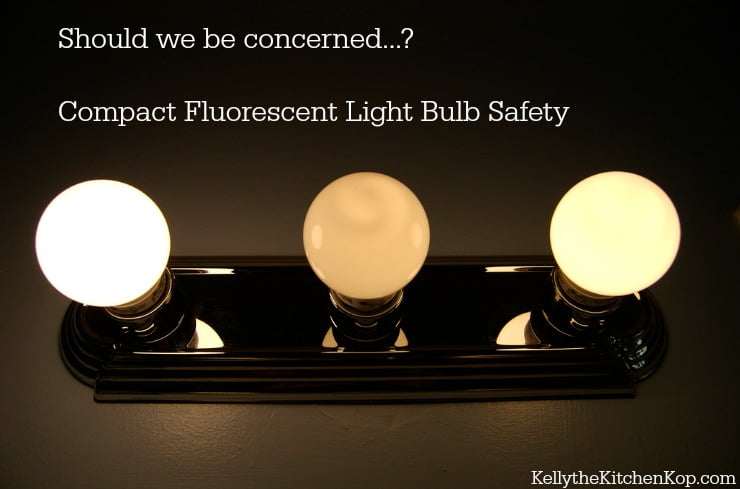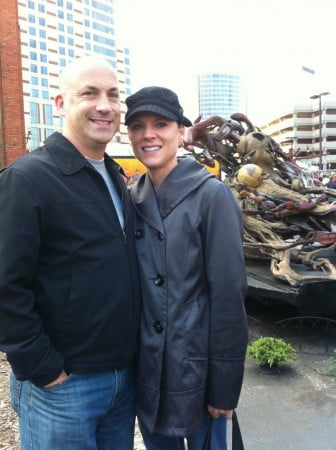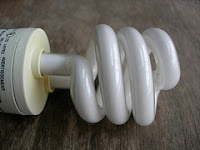
Should we be concerned about compact fluorescent light bulb safety?
Our friends, Bob & Sonia, are our main source for information on “green” issues. Recently I gave Bob a paper someone had given me, that claimed fluorescent light bulbs aren't all they've been cracked up to be, due to their mercury content, with one person claiming to have broken out in hives from using them in his home. We recently began using these, so I was very curious.
I asked Bob about it, and here is his reply:
Hey Kel-Sonia came home and shoved a piece of paper in my face and told me to read it and give you my take on it. As I'm used to these sorts of bizarre orders from her, I did it…
I'll be honest with you, I don't think this person's hives problems come from the mercury in the light bulbs.
- First, fluorescent light bulbs have been around forever, since the 40s or 50s, and have always had mercury in them, and would have bothered this person at school, at work, shopping in stores, etc. Fluorescents are everywhere!!
- Second, the CFLs made today have a lot less mercury in them than even a few years ago, and companies are working hard to eliminate it altogether in the next few years. (I'm a CFL expert, I bought my first one in 1990, paid 50 bucks for it, and it was so big it didn't fit in the one lamp I owned at college! It lasted almost 15 years, and yes I still have it.)
- And third, the small amount of mercury in the bulb is contained within it, and is only really a problem if the bulb breaks. Old CFLs shouldn't be thrown out with the regular garbage, but lots of retailers are starting take-back programs where they'll take your old bulbs and dispose of them properly. I know Wal-Mart does this already.
I think the small amount of mercury in the bulbs is far outweighed by the huge gains in efficiency.
Most of our electricity comes from burning coal, which is the largest source of mercury in our environment. The CFL uses 75% less electricity, so it actually helps keep mercury out of the air.
Here's some info I found from the EPA:
“Ironically, compact fluorescent bulbs are responsible for less mercury contamination than the incandescent bulbs they replaced, even though incandescents don't contain any mercury. The highest source of mercury in America’s air and water results from the burning of fossil fuels, such as coal, at utilities that supply electricity. Since a compact fluorescent bulb uses 75 percent less energy than an incandescent bulb, and lasts at least six times longer, it is responsible for far less mercury pollution in the long run. A coal-burning power plant will emit four times more mercury to produce the electricity for an incandescent bulb than for a compact fluorescent.”
Wow, I guess I got up on my soapbox, didn't I? Don't get me goin'!! I'm a geek for energy efficiency and environmental stuff like you are for food & nutrition. (And airplanes!)
THANKS BOB!!
- Check this out: Bob's Guest Interview
- More on this topic from Green & Clean Mom
- This NPR article reminds us to be sure to recycle our fluorescent bulbs!
- Home Depot to begin recycling fluorescent light bulbs
- Wondering about the safety of the various plastics in your life?
- Scroll down at this link to find out what steps to take for your safety if a fluorescent light bulb breaks (I had no idea that could be so dangerous!)
- It's farm market time!



Bob A says
Not to kickstart an old article or anything, but I’ve written about a new LED light bulb made by a company called Cree. I actually have a couple of these bulbs, and they are awesome. They look like old-fashioned incandescent bulbs (well, kind of), use a lot less energy (85% less), and only cost about $12 (most other LEDs are much more expensive). They are also assembled right here in the USA. They’re only available at Home Depot but are worth checking out. https://green-home-product-source.com/cree-led-light-bulb.html
Bob A. says
Aaron, you’re absolutely right, there’s no more efficient light bulb, fluorescent or incandescent, than one that’s turned off. We’ve been using CFLs for many years, and the light quality varies quite a bit. There are definitely some that I wouldn’t recommend reading by. I’ve noticed that the light bulb companies have gotten much better at describing the quality of the light a particular bulb emits, and the light quality has improved as well. We’ve found we like the bulbs described as “soft” give off the most pleasant light for our taste. It’s more like the yellowish light an incandescent gives off, and we don’t mind reading by it at all. But like most everything, personal tastes vary.
Kelly says
Mr. Picklehead, right here at my blog, how exciting!!!
I’ll make sure Bob sees your comment, he’ll probably have something intelligent to say in reply to your question, because I know nothing about the topic.
Except I do know how to turn lights off when I leave a room, I’m pretty good at that. 🙂
See you next week, Aaron!
Kelly
Aaron says
Just wondering if people care about direct vs. diffused lighting? Ugg. I can’t stand to read by CFL. How about being truly efficient and switching off the unnecessary lights?
Andrew says
Yes, CFLs have less mercury in them than the mercury emitted from a power plant, but unless you have a power plant’s smoke stack in your child’s bedroom, it’s far from a fair comparison.
Kelly the Kitchen Kop says
If you don’t know of a local Hazmat event like Anna mentioned, Bob also said that Walmart takes old bulbs and according to the link above, now Home Depot does, too.
Anna says
It’s always good to get a second or third or even fourth opinion, isn’t it?
I’ve been using CFBs for years; now every fixture in the house has CFBs (even my recessed “can” lights), except for over the dining table, because I have a dimmer switch on that one. The new dimming CFBs need a lot of work still – they flicker and the wattage/brightness is too low when undimmed. I’ll try them again when dim-able CFBs improve.
I keep a box in the garage to hold small stuff that can’t go in the regular garbage collection – spent CFBs, dead short fluorescent tubes from my under-cabinet kitchen fixtures, and dead rechargeable batteries, etc. Once or twice a year or so I discard the stuff at a community haz-mat type event (I mark my calendar to make sure I don’t miss it). I cushion the box interior with crumpled newspaper to make sure the glass doesn’t break.
Bob A. says
We’ve had CFL’s in our garage for 8 years now and haven’t had to replace them yet. We also have had 3 of them on our outdoor light fixtures exposed to the heat and cold for years with no problem. If you use them outside just make sure they’re protected from the rain and snow.
Holly says
Green bulbs, green beans, all makes sense to me!
Kelly the Kitchen Kop says
I didn’t know they had different ratings! Ours ARE in our garage, hopefully they last.
Natalie says
I just had one of these CFL bulbs burn out after only being installed maybe a year or less. Perhaps this is a fluke, but now it sits in the garage waiting for me to figure out how to get rid of it.
Be sure when you purchase these bulbs that you check the temperature rating on the particular brand you are purchasing. If you are installing them in your unheated garage, you need to make sure they are rated for low temperatures.
Kelly the Kitchen Kop says
Somehow there got to be a few comments related to this post, below in the “Baked Garlic Green Beans” post, so check those out if you’d like.
Kelly the Kitchen Kop says
Funny you say that, he has agreed to be my new “Green Geek” and will post here now and then!! 🙂
Holly says
This is great information. If Bob has, or starts a blog, I would love to have a link!